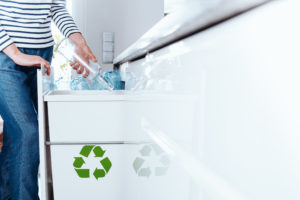
Blog
Eastman: Adopting a Circular Mindset with Material-to-Material Recycling
Imagine all the items you’ve purchased, used and discarded in your lifetime. Now consider how much space that would take up – not to mention what’s discarded by your neighbors, friends and family. From cars to toys to electronics, appliances, textiles, building materials, packaging, household goods and decorations, we buy, use and discard so much that’s made with plastic.
And since they seemingly disappear once we toss the items, we might not give much thought to their next journey. Unfortunately, most of what we discard will end up in a landfill, doomed as forever trash — a concept that is uniquely human. We make so much of this waste that we’re running out of landfill space globally.
But what if we could turn our old, discarded, no-longer-useful plastic into new things? Material-to-material recycling can help reduce our strain on natural resources and avoid digging giant holes and using our land to bury waste. It would reduce pollution and chemicals polluting local environments and it would reclaim and repurpose valuable materials and ultimately reduce our overall carbon footprint.
The first step in changing our recycling story is adopting a circular mindset, recognizing the inherent value in plastic and reusing it accordingly – and molecular recycling, in partnership with mechanical recycling, can help us close that loop. By embracing molecular recycling, we can reduce our dependency on fossil fuels, mitigate the prevalence of plastic waste in our environments and landfills, create value for end-of-life plastics and transform existing plastic back into molecular building blocks for future products. This transition would create a circular economy, reducing our dependence on natural resources and minimizing our negative impact.
Right now, mechanical recycling is the dominant method for recycling plastic, but it’s limited to certain types of plastic and certain types of future uses. Others that aren’t recycled or landfilled may be burned for fuel. While mechanical recycling has the lowest carbon footprint and is the most cost-effective and efficient recycling option, it has further limitations, starting with the very narrow range of simple plastics it can process, like clear plastic water bottles and natural gallon milk jugs. Also, plastics that are mechanically recycled degrade each time they’re processed until they can’t be mechanically recycled anymore. Mechanical recycling is finite. It needs to be constantly replenished with virgin quality material. Molecular recycling can provide that virgin quality material because by going back to the basic molecular building blocks and rebuilding the polymer — no matter how many times they’re processed — produces products with no compromise in safety, quality or performance. And the vast types and amounts of plastic items that cannot be mechanically recycled — colored plastic bottles, eyeglass frames, food containers and polyester carpet are just a few — can be processed by molecular recycling.
To achieve true material circularity, we need material-to-material molecular recycling. To create a circular economy, we need to invest in better access, collection and sorting within the mechanical recycling system. We also need to build an infrastructure that supports molecular recycling to revolutionize materials we can’t recycle through conventional means.
We know consumers are looking for recycled content, which also means companies are looking for recycled materials – this is where molecular recycling has a void to fill. But there’s a challenge because we don’t have a clear and consistent approach to collecting and recycling more plastics. To activate material circularity through molecular recycling, we need to aggressively pursue: designing for recyclability, improving access to recycling for a majority of households, maintaining infrastructure for collecting and sorting waste and transporting it to proper recycling facilities, operating molecular recycling facilities at scale and enacting policies that enable the development of effective recycling technologies.
We’re working closely with waste management companies to create new feedstock streams. We’re also supporting take-back programs and collection efforts. That includes The Recycling Partnership’s PET Recycling Coalition, which offers grants to fund viable research, infrastructure and knowledge sharing to help capture more PET waste for recycling. We’re engaging in meaningful partnerships that are critical for scaling the circular economy.
Beyond that, we’re making significant investments in facilities that can implement molecular recycling and turn hard-to-recycle plastic waste into feedstock for new materials and products.
An advantage of Eastman molecular recycling is that it recycles a wide range of materials that cannot be mechanically recycled. These technologies provide a means to recycle not just more plastic but more types of plastic — meaning less ends up in landfills.
Published on October 19, 2023




